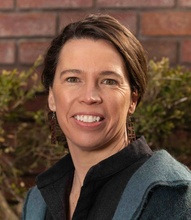
Prof. A. Gannet Hallar, at the Department of Atmospheric Sciences at the University of Utah, presented the Climate / Atmospheric Science & Engineering (CASE) Colloquium series in March. Prof. Hallar's topic was "Storm Peak Laboratory: 40+ Year History of this Mountain-Top Research Facility."
The CASE Colloquium is presented by the Center for Global and Regional Environmental Research and the Iowa Technology Institute. Find past CASE presentations here.
Here watch the video play and find more details below.
ABSTRACT: Storm Peak Laboratory, located near Steamboat Springs, CO, is an internationally recognized high-elevation research station that has been used for over 40 years. Storm Peak Laboratory (SPL) is available for usage through request as part of the NSF Facility and Instrumentation Request Process (FIRP). Storm Peak Lab is proud to be among 16 other world class facilities that incorporate the NSF Facilities for Atmospheric Research and Education (FARE). Most recently, SPL has transferred operations to the University of Utah from the Desert Research Institute. To date, research at SPL has produced over 140 peer-reviewed publications. Cloud and aerosol measurements began at the Steamboat Springs Ski Resort in northwestern Colorado in 1979. Today’s permanent mountaintop facility underwent an NSF-funded extensive remodel and expansion in 2012, making it easily accessible for researchers, teachers, and students of all abilities. SPL has a full kitchen and overnight living accommodations for 11 people. SPL operates under a special use permit from the U.S. Forest Service. SPL provide a unique training, education and networking environment that strengthens scientific skills and inspires leadership. For example, SPL hosts undergraduate atmospheric science field courses organized by numerous institutions, including Colorado State University, Yale University, Hendrix College, University of Wisconsin, University of Nevada, and Texas A&M University. SPL also integrates hydrology field courses from the University of Colorado with atmospheric science courses. Approximately 100 students annually participate in these courses. In addition to the ~1,000 students trained via field courses in the last decade, we estimate that to date approximately 40 graduate students have used data from SPL as the foundation for either a M.S. or Ph.D. thesis. This presentation will discuss past and present research and training at SPL, along with future plans.
BIOGRAPHY: The overarching theme of my research is using high quality measurements of trace gases, aerosol physical and chemical properties, and cloud microphysics to understand connections between the biosphere, atmosphere, and climate, along with the impact of anthropogenic emissions on these connections. More specifically, currently my research uses high elevation sites, combined with airborne measurements, to study the formation processes of Cloud Condensation Nuclei (CCN) and Ice Nuclei (IN) and how differing formation processes impact mixed-phase cloud microphysics. This research topic is stemmed in many potential formation mechanisms of aerosols, including nucleation, secondary organic aerosols, and primary biological aerosol particles (PBAP’s). In addition to my research, I guided two large National Science Foundation programs to support diversity in the atmospheric sciences. Geoscience Research at Storm Peak (GRASP) is a program providing mentoring and field research experiences for a diverse group of undergraduate students. Atmospheric Science Collaborations and Enriching NeTworks (ASCENT) is a program focusing on women in atmospheric science/meteorology to initiate positive professional relationships among female faculty of different ranks and postdoctoral researchers. Finally, I am interested in science administration and have served as the Program Director of Physical and Dynamic Meteorology within the Division of Atmospheric and Geospace Sciences at the National Science Foundation.
